Table of contents
- Product test: automatic switchgear Shift at full throttle and save tenths of a second
- Bazzaz QS4
- Dynojet Ignition Quickshifter
- KLS MQS-SU
- Lohmann FSM Evo
- Starlane Power Shift NRG IS
- Plate CTS7F
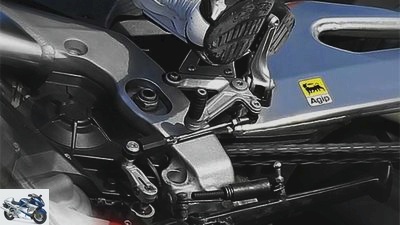
fact
accesories
Motorbike gearshifts for the racetrack being tested
Product test: automatic switchgear
Shift at full throttle and save tenths of a second
Content of
Automatic gearshifts for motorcycles enable gearshifts at full throttle and should save decisive tenths of a second on the racetrack. How good are retrofit systems and how easy they can be installed? PS tests automatic switchgear.
Mathias Heerwagen
October 18, 2011
Which racer wouldn’t want to go a few tenths faster per lap straight away? It’s relatively easy to do with just one trick: you don’t have to take the gas off and use the clutch when upshifting – you simply press the next gear. However, changing gears under load and without the clutch damage the gearbox, and gearbox damage can occur after a short time. Automatic switchgear, or quickshifter, are supposed to prevent that. Put simply, a sensor on the gearshift linkage recognizes the driver’s request to shift, a control unit then interrupts the ignition for a few milliseconds and thus takes the load off the gears – the gear engages gently, precisely and quickly without having to engage the clutch. That’s the theory. But what does the practice look like??
At the start are automatic switchgear from the manufacturers Bazzaz, Dynojet, KLS, Lohmann, Starlane and Tellert. A Suzuki GSX-R 1000 is used as a test motorcycle. With her, the switching pattern can be reversed as standard. Means: first course upstairs, the rest downstairs. This scheme is popular on racetracks because the driver only has to step on the gear lever when accelerating in an inclined position and does not have to laboriously squeeze his foot under the gear lever. Disadvantage of the GSX-R 1000: Like all younger Suzukis, it has the special feature that if the ignition is interrupted for more than 65 milliseconds, the FI lamp in the cockpit flashes and the electronics store an error message until the ignition is switched off and then again is switched on.
The automatic switchgear supplied should prevent exactly that. Due to additional components, however, they sometimes cost significantly more than the normal versions that work with any other brand without any problems.
According to the operating instructions, the Quickshifter can all be installed very easily and without special tools. That’s often true, but not always. While the installation of the shifters from Bazzaz, Dynojet and Lohmann is almost self-explanatory thanks to the plug-and-play systems used, the installation of the Starlane, Tellert and KLS requires careful reading of the instructions. With these models, the four pulse-carrying ignition cables between the control unit and the ignition coils have to be cut and the respective electronics connected in between. Those who do not trust themselves to do fine soldering work on the wiring harness should have these automatic switchgears installed by the dealer or use so-called soldered connectors. These are plugged onto the cable ends and simply heated with a lighter or other heat source. A ring made of solder runs inside and securely connects the cable ends with one another.
The automatic switchgears hardly differ in terms of assembly time and effort. Nevertheless, the systems in which the ignition cables have to be disconnected get one point deducted in the “assembly effort” criterion. The original condition is difficult to restore, and not everyone can solder or has the right tool in the garage.
Tellert provides the best instructions in the test. 16 pages describe exactly and understandably how the “CTS7F” is installed and adjusted, detailed photos supplement the text. In addition, there are exact connection plans with correct terminal designations and cable colors from the most important manufacturers. This plan is great to work with.
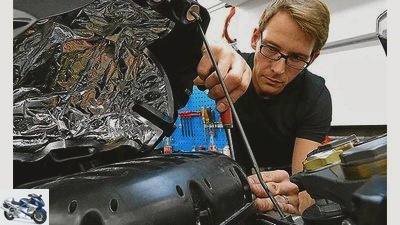
Sdun
Airbox down, airbox up again – we screwed up for more than a week and tested the machines over a distance of around 2500 kilometers.
Quite different at KLS. The “MQS-SU” can hardly be installed by the hobby racer himself with the enclosed instructions alone. On the one hand, because two holders or levers for the sensor box have to be laboriously made from metal sheets and angles. With a little time and patience, however, this can be achieved. What is worse is that the supplied block diagram is only a rough representation and, at least in our case, is not suitable for installation. An original circuit diagram was required, which we requested from Suzuki. He revealed that the shifter can only be installed with considerable effort. In addition to the impulse-carrying cables, the current-carrying cables on the ignition coils would also have to be cut. Out of consideration for the test motorcycle and for reasons of time, we decided to cancel the test for the KLS system.
In defense of KLS, it should be said that the automatic gearshift is usually only installed once on private individuals and then remains on the motorcycle – which may justify the effort. Nevertheless, KLS has to put up with the question of why the most expensive system in the test is not nearly as easy to install as, for example, the more than 200 euros cheaper automatic switchgear from Bazzaz or Starlane, which also work well.
All of the tested automatic switches have one thing in common: They work best when used appropriately, i.e. at high speeds. Powerful, fast shifting brings optimal results with barely noticeable gear changes. Timid plucking at the gear lever is out of place. Even if the classic method – pulling the clutch and shifting – costs time and causes unrest in the chassis, the gear changes still feel much smoother than with most shifters. The exception is the plate, which enables the smoothest gear changes by far.
In terms of their function, the machines are very close to one another, there are no major differences. This may be due to the fact that the preset interruption times for all shifters (except for Tellert and KLS) are in the range of 50 to 65 milliseconds and are based on the experience of the manufacturer. Depending on the number of revolutions and gear changes, one or the other of the gearshifts feels better.
Finally, a few words on the legal situation: All providers point out that the automatic switchgear may only be used on closed routes. Anyone who has an accident in public road traffic with a mounted automatic switchgear risks insurance cover and / or can be recourse to the insurance company.
Bazzaz QS4
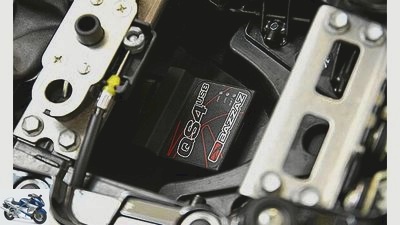
Army car
Well hidden: electronics box in the rear.
Contact
Bazzaz, Bikeshop-Luchow, 29439 Luchow, Tel. 0 58 41/97 40 40, www.bikeshop-luechow.de
price 499 euros
Conclusion
The Bazzaz QS4 is amazingly easy to assemble and can be set up in no time using the supplied software on a laptop. Even in the factory settings, the automatic machine enables relatively smooth gear changes, especially at high speeds. Every now and then you can still feel a slight jerk, depending on how powerfully and precisely you shift. Shifting below 6000 rpm makes little sense with the Bazzaz, the shifting processes are then sometimes clearly noticeable.
plus
Simple installation via plug-and-play, high-quality wiring harness with shift light output, comparatively inexpensive, smooth and precise shifting processes at high speeds
minus
At low speeds (below 6000 rpm), gear changes are sometimes clearly noticeable
PS judgment: good
Dynojet Ignition Quickshifter
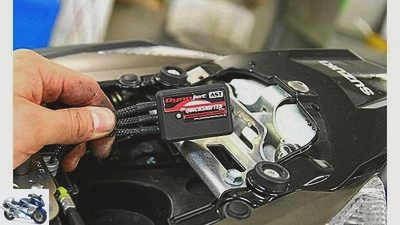
Army car
Finds space under the pillion seat: the electronics box on the slightly too long cable harness.
Contact
Micron Systems, 90765 Furth, Tel. 09 11/93 67 40, www.micronsystems.de
price 578 euros
Conclusion
The Dynojet Quickshifter impresses with its easy assembly, ignition cables do not have to be cut. Special feature: the automatic switch can be connected to an existing Dynojet power commander. The sensor only works on pulling or pushing, which means that the switching scheme cannot be reversed at will. Another sensor costs an impressive 259 euros. The gearshifts are relatively smooth over the entire speed range, although a slight jolt can be felt every now and then.
plus
Easy to assemble, can be combined with existing power commanders, smooth switching processes even from low speeds
minus
Interruption times are a bit difficult to set, the sensor can only be used for pulling or pushing, the (universal) cable harness is a bit too long
PS judgment: good
KLS MQS-SU
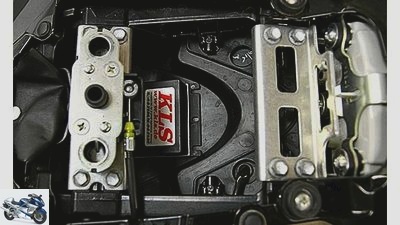
Army car
The electronics box also disappears here in the rear.
Contact
KLS-Motorsport, 81479 Munich, Tel. 0 89/79 19 90 43, www.kls.de
price 719 euros
Conclusion
A test of the KLS automatic switchgear was not possible because the very complicated installation was not justifiable in the time available to us. Overall, we spent more than a day assembling the “MQS-SU”. With this system, the mounting of the sensor box on the motor has to be painstakingly made by hand. The same applies to a link lever on the shift linkage that actuates the slide switch. Not to mention the complex connections of the electronics.
plus: –
minus:
Inadequate installation instructions and complicated connection of the electronics, cumbersome installation of the sensor box on the gear lever and frame / motor, most expensive shifter in the test.
Lohmann FSM Evo
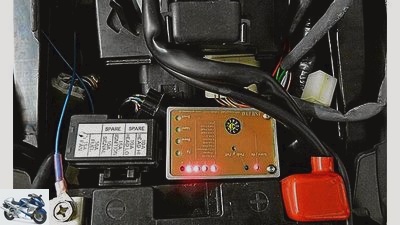
Army car
The box fits behind the battery; The interruption time can be set using touch buttons.
Contact
MCT Lohmann, 30851 Langenhagen, Tel. 05 11/74 42 12, www.mct-lohmann.de
price 509 euros
Conclusion
Together with Bazzaz and Dynojet it is the easiest to assemble automatic switchgear – the installation and adjustment instructions are understandable and leave no questions unanswered. The interruption times for the five channels of the FSM Evo are preset and should only be changed by a specialist. However, this is hardly necessary because relatively smooth gear changes are possible even in the basic setting. Depending on the speed and the hardness of the shifting process, you can feel a jolt in the drive train from time to time.
plus
Uncomplicated installation via plug-and-play, interruption times that can be easily changed by a specialist, also works with the switching scheme reversed (adjustable by pull or push)
minus
Shifting processes not as soft as with the test winner (Tellert)
PS judgment: good
Starlane Power Shift NRG IS
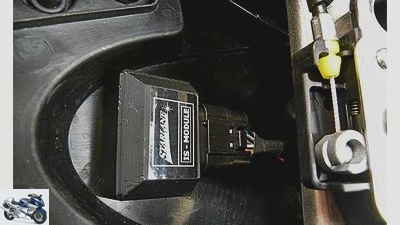
Army car
We already know the picture: The Starlane box is also attached to the rear.
Contact
Engel-Tuning, 14947 Nuthe-Urstromtal, Tel. 0 33 71/40 14 40, www.starlane24.de
price 487 euros
Conclusion
The cheapest sensor in the test feels most comfortable beyond 8000 rpm – then the gears can be stepped through with almost no jerks. The preset ignition interruption of 50 milliseconds (ms) actually always works, a test extension to 70 ms did not bring any improvement. The sensor in the shift linkage may only be tightened slightly (with 9 Nm) and can loosen, hence our tip: Counter the tiny sensor with a self-locking nut and use a drop of medium-strength screw locking device.
plus
Almost jerk-free gear changes at high speeds, sensor works in both directions – pulling and pushing, easy changing of the interruption time, good installation instructions
minus
Ignition cables must be disconnected, interruption time cannot be set individually for each gear, very thin sensor cable
PS judgment: good
Plate CTS7F
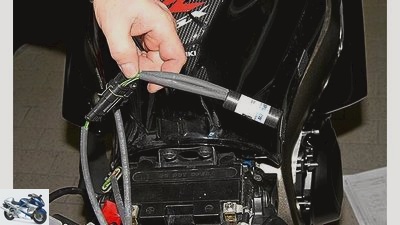
Army car
A special additional module for Suzuki motorcycles suppresses the error message “FI” in the cockpit.
Contact
Tellert Elektronik GmbH, 97440 Werneck, Tel. 0 97 22/92 46, www.tellert.de
price
644 euros
Conclusion
The Tellert CTS7F is convincing all along the line. The installation is a bit complicated, but the increased effort is offset by extremely smooth gear changes. The plate does not interrupt the ignition for a specified time, but for the duration of the shift – a sensor detects whether the gear is actually in and only then releases the ignition again. Advantage for switching scheme changers: The force sensor works in both push and pull direction.
plus
Best installation instructions in the test, buttery smooth gear changes even at low speeds, force sensor can be converted from pulling to pushing direction
minus
Ignition cables have to be separated and soldered back together, adjusting the position sensor is not that easy
PS judgment: very good
Related articles
-
The most beautiful race track in the world: Bikers Classics in Spa 2012
Hecker 26th pictures Hecker 1/26 The perfect weekend – Bikers Classics in Spa. Hecker 2/26 A fairy in the neighbor’s box: Wendy Newton from California…
-
Meyer, BILLION 44 pictures mps 1/44 Many heads, one opinion: fitting problems usually run through many sizes. mps 2/44 Conclusion on the IXS HX 510: A…
-
10 enduro and adventure helmets tested
Tobias Beyl 29 pictures Tobias Beyl 1/29 Five of each helmet model competed for the test: one each in S, M, L and XL for the test drives. Klaus Herder…
-
Wilbers suspension elements for the BMW R nineT being tested
Bilski 11 pictures Bilski 1/11 Among other things, Wilbers offers an alternative shock absorber for the R nineT. Optionally complete (whoever wants with…
-
manufacturer accesories tire Guide: new tires being tested Guide: tires New tires put to the test MOTORRAD tested various new tires for enduro, tourers…
-
PS-TuneUp Triumph Daytona 675 race track tuning
Feulner 17th pictures Andreas Feulner 1/17 PS-TuneUp has set itself the task of forging a good racing athlete into a hot race track sweeper with the…
-
Flip-up helmets tested: 14 motorcycle helmets – ECE standard ECE-R 22-0
clothing Helmets Flip-up helmets tested: 14 motorcycle helmets / ECE standard ECE-R 22-0 Flip-up helmets in the test Comparison: 14 folding motorcycle…
-
European Bike Week 2017 – Harley-Davidson Flat Track Race
Harley-Davidson Sports & scene Events European Bike Week 2017 – Harley-Davidson Flat Track Race Harley Davidson organizes flat track races European Bike…
-
Over the mountain race routes in Franconian Switzerland
fact to travel Over the mountain race routes in Franconian Switzerland Life: Over the mountain race routes in Franconian Switzerland It’s a pleasure to…
-
Motorbike sat navs and apps put to the test – navigation devices for motorcyclists
Photo: Lohse 15th pictures Garmin 1/15 Garmin Zumo 390 LM, 449 euros – purchase tip in MOTORRAD 18/2015: Except for the poor navigation result on the…